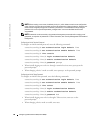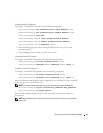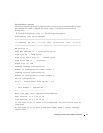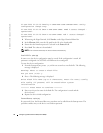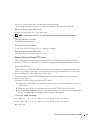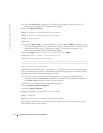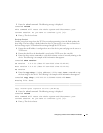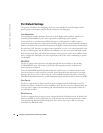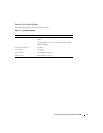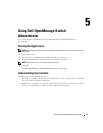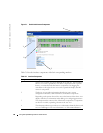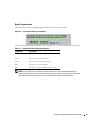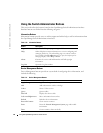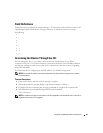
76 Configuring PowerConnect 3424/P and 3448/P
www.dell.com | support.dell.com
Port Default Settings
The general information for configuring the device ports includes the short description of the
auto-negotiation mechanism and the default settings for switching ports.
Auto-Negotiation
Auto-negotiation enables automatic detection of speed, duplex mode and flow control on all
switching 10/100/1000BaseT ports. Auto-negotiation is enabled per port by default.
Auto-negotiation is a mechanism established between two link partners to enable a port to
advertise its transmission rate, duplex mode and flow control (the flow control default is disabled)
abilities to its partner. The ports then both operate at the highest common denominator between them.
If connecting a NIC that does not support auto-negotiation or is not set to auto-negotiation, both
the device switching port and the NIC must be manually set to the same speed and duplex mode.
If the station on the other side of the link attempts to auto-negotiate with a device 100BaseT port
that is configured to full duplex, the auto-negotiation results in the station attempting to operate
in half duplex.
MDI/MDIX
The device supports auto-detection of straight through and crossed cables on all switching
10/100/1000BaseT ports. The feature is part of the Auto-negotiation and is enabled when
Auto-negotiation is enabled.
When the MDI/MDIX (Media Dependent Interface with Crossover) is enabled, the automatic
correction of errors in cable selection is possible, thus making the distinction between a straight
through cable and a crossover cable irrelevant. (The standard wiring for end stations is known as
MDI (Media Dependent Interface), and the standard wiring for hubs and switches is known as MDIX.
Flow Control
The device supports 802.3x Flow Control for ports configured with the Full Duplex mode. By
default, this feature is disabled. It can be enabled per port. The flow control mechanism allows the
receiving side to signal to the transmitting side that transmission must temporarily be halted to
prevent buffer overflow.
Back Pressure
The device supports back pressure for ports configured with the half duplex mode. By default, this
feature is disabled. It can be enabled per port. The back-pressure mechanism prevents the sender
from transmitting additional traffic temporarily. The receiver may occupy a link so it becomes
unavailable for additional traffic.



